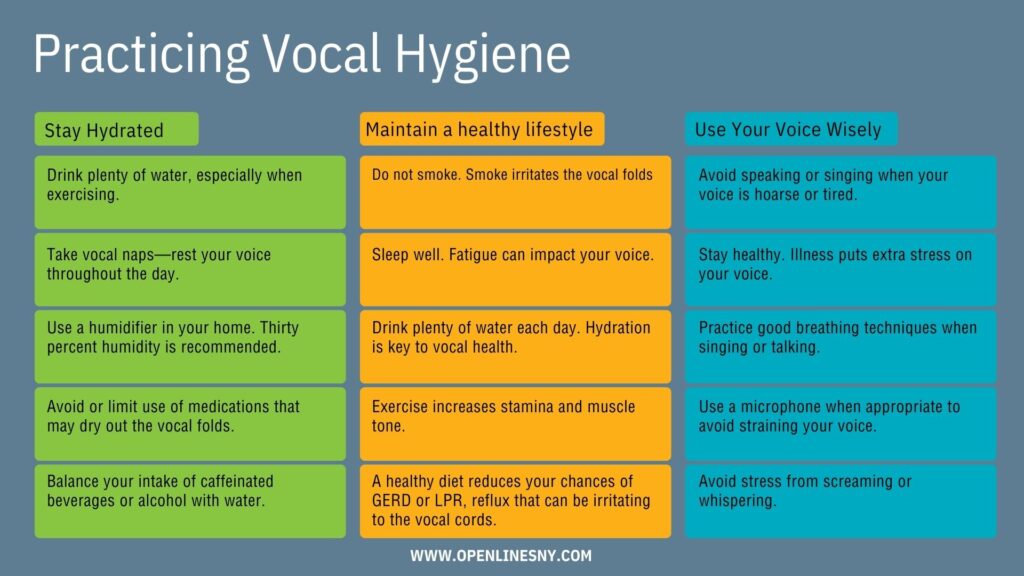Can You Heal Damaged Vocal Cords?

Many of us take for granted how deeply we rely on our voice to convey our personality and our true sense of self. Through our pitch, tone, vocal quality, intonation patterns, and volume we communicate confidence, emotion, and in many ways, our identity.
For example, the vocal cords (aka vocal folds) are hard at work each day to produce sound. They come together and vibrate as air passes through them during exhalation. Vocal cords must vibrate together with the same force and speed to produce a clear sound. In certain cases, trauma can damage the vocal cords. Many people ask if this damage can be healed or if it is permanent? To answer this question, we asked Dr. Jessica Galgano, executive director and founder of Open Lines Speech and Communication, to discuss why vocal cord damage happens and offer tips on how to treat and prevent this issue.
What Is a Voice Disorder?
A voice disorder refers to a variety of symptoms that negatively impact a person’s voice or the ability to talk. Symptoms may include difficulty varying pitch to express emotion, experiencing pain, discomfort, or fatigue when speaking, difficulty speaking loud enough to be heard, or exhibiting a croaky, breathy, or strained vocal quality.
Some of the most common reasons for voice disorders include:
- Muscle tension dysphonia
- Laryngitis
- Polyps
- Nodules
- Cysts
- Paradoxical Vocal Fold Movement
- Vocal cord paralysis or paresis
- Neurological disease, such as Parkinson’s, Essential Tremor, or stroke
- Cancer
“A disruption in our ability to control any aspect of our voice can be extremely stressful and provoke anxiety, which then further impacts or worsens the symptoms of the voice disorder,” Dr. Galgano said. “Ramifications may be felt throughout personal, social, and professional areas of life and can affect one’s sense of identity. It is not uncommon for individuals with voice disorder to experience a decrease in self-confidence and a negative impact on their interpersonal relationships and ability to participate fully in life.”
What Damages Vocal Cords?
Vocal cord damage can occur from the following three factors:
- Functional (misuse, abuse, or chronic stress)
- Neurological (associated with underlying neurologic conditions)
- Organic (structural changes to the larynx)
The symptoms you experience can vary from mild to severe and may come-and-go or be chronic.
Functional Voice Disorders
Functional voice disorders result from improper or inefficient use of the voice when the physical structures are normal. These can occur when the voice is produced with excessive muscle tension and sometimes result in vocal fatigue. These types of voice disorder are among the most common in adults and children.
Chronic misuse can cause changes in the way the subsystems of respiration/breathing, phonation/voicing, articulation, and resonance work together. This can result in inefficient breathing patterns and muscle tension. Over time, these habits can lead to phonotrauma (stressed placed on vocal cords), edema (swelling), vocal fold nodules, discomfort or pain, which then make the problem organic in nature. Subsequent changes to vocal quality, pitch, resonance, and loudness can then occur. Psychogenic influences including those related to stress, anxiety, and depression may also contribute to a range of voice problems.
“Overlap is common in voice disorders. Take vocal fold nodules, for example. The cause of these callous-like structures on the vocal folds is functional because many times they are a result of misuse, overuse, or inefficient use of the voice,” Dr. Galgano said. “This can then result in repeated trauma to the vocal folds, which may then lead to structural (organic) changes to the very sensitive tissue of the vocal folds. In these cases, there are no initial anatomical issues present, but the voice may be used in inefficient or harmful ways that lead individuals to exert too much muscular effort when they speak,” Dr. Galgano said. “Sometimes this may occur because of environmental conditions, such as having to speak loudly in noisy or stressful environments, which may be the case for professional voice users, such as executives, attorneys, artists, or teachers.”
Organic Voice Disorders
Organic voice disorders are a result of changes in respiratory, laryngeal, or vocal tract mechanisms. These can be caused by structural alterations or changes in the way the brain controls the systems involved in voicing.
- Structural voice disorders result from physical changes in the voice mechanism, such as vocal fold paralysis/paresis following surgery, changes in the cellular makeup of vocal fold tissues due to reflux or allergies, or structural changes in the larynx due to aging.
- Neurogenic voice disorders are associated with a range of neurological disorders and diseases that cause neurological, physiological, and anatomical changes in one’s ability to voice and speak. These types of voice disorders may result due to a stroke, essential tremor, spasmodic dysphonia, dystonia, paradoxical vocal fold motion disorder, or voice changes associated with diagnoses, such as ALS, Parkinson’s disease, multiple sclerosis, Huntington’s Chorea, or myasthenia gravis.
Voice Therapy for Damaged Vocal Cords
Participating in voice therapy can allow you to speak with greater ease and comfort so you can be better understood and enjoy greater quality of life!
As with all forms of speech, language, or voice therapy, the interventions used depend many factors, such as the nature and severity of the issues as well as the goals and speaking demands placed on the individual. However, in general, treatment is aimed at improving underlying anatomical changes or strengthening physiological weaknesses which contribute to voice problems. Each individualized plan of care trains each person to use healthy and efficient ways to engage breath and produce voice, to implement compensatory strategies when needed, and modify environmental conditions and/or reduce circumstantial barriers that may be limiting successful communication.
How to Strengthen Vocal Cord Muscles
The techniques, methods, and intensity of your therapy depend on many factors. Before starting voice therapy, you should have a consultation with an otolaryngologistear-nose-throat doctor (ENT.) These doctors specialize in disorders of the head and neck area. If you are a professional voice user, you may also want to seek out a laryngologist, which is an ENT who specializes in the voice. If you are unsure of who to work with because there are so many choices out there, you may choose to come in for your initial assessment with one of our specialists who can recommend options specifically for you.
After this appointment, a licensed speech language pathologist (SLP) who specializes in voice will then complete a comprehensive individual voice assessment to learn more about the strengths and challenges you are facing, as well as your personal goals and preferred timeline. This information will help your SLP develop a personalized plan of action with specific and personally relevant exercises to help you achieve a successful outcome as quickly as possible.
“People with muscle tension dysphonia sometimes benefit from resonant voice therapy, which helps a person achieve a more balanced oral-nasal resonance without feeling like they need to push to keep the voice going,” Dr. Galgano said. “This type of approach helps a person produce voice with a healthy quality in an easy manner without extraneous muscle tension.”
“Another effective treatment approach includes vocal function exercises, which utilize a systematic and hierarchical series of voice manipulation techniques designed to improve vocal quality and comfort by strengthening and improving the coordination and efficiency of breathing, voicing, and vocal tract manipulation.”
Expiratory Muscle Strength Training (EMST) is exercise aimed at enhancing respiratory strength and improving the relationship between breathing and voicing. People with voice issues related to underlying respiratory issues, including presbyphonia (aging), allergies, or other illnesses may benefit from EMST.
People with age-related voice changes and people with neurologically-based voice and speech disorders disorders typically benefit from LSVT LOUD. This program has three randomized controlled trials (very high quality research) and almost 20 peer-reviewed published studies demonstrating efficacy (that it works) and the basic mechanism of change underlying improvements (how and why it works.) LSVT LOUD utilizes a target of normal loudness that impacts speech clarity, breathing kinematics, vocal quality, and intonation so people can be more clearly heard and understood. It is conducted in an intensive format that incorporates theories of motor skill acquisition and neuroplasticy to help people achieve results quickly and make results last. LSVT LOUD is the gold standard approach for improving respiratory-voice-speech disorders in neurologically based communication disorders but needs to be administered correctly. Too often, people are cheated out of the results they have the potential to achieve because a facility or clinician did not correctly administer LSVT LOUD.
How Long Does it Take for Vocal Cords to Heal?
The way we speak and use our voice involves a many factors and long-established, automatic habits. Thus, Dr. Galgano noted it can take time and dedication to exercises to retrain these habits and, most importantly, feel natural and like oneself when producing voice in a healthy manner.
“In our experience, it is motivation and intensity of practice that drive how quickly gains are made in one’s individual program,” she said. “Other factors include your specific goals (e.g., rebuilding strength and coordination following surgery or establishing healthy vocal habits and skills in the workplace), the extent of your injury, and your feelings or beliefs about your difficulties.”
The good news is that many treatment programs can quickly yield meaningful, positive results! For example, Dr. Galgano said participating in an intensive program for neurologically-based respiratory-voice disorders with sessions four to five times a week for one hour each day combined with a home exercise program will lead to improvements in vocal function in one month. At Open Lines®, people then have the option to subscribe to a maintenance program on a monthly basis to sustain and exceed your goals.
If you are participating in speech therapy to reduce vocal fatigue, tension, and improve overall vocal quality and comfort, you can expect to see results within one to three months. Individual goals may vary, and you can continue exercise sessions to meet and exceed your specific needs.

Why Is Vocal Health Important?
Vocal health is just like any other health aspect — the more proactive and aware you are, the more likely you are to avoid any vocal complications. Good vocal hygiene plays a vital role in optimizing vocal health so you can keep your voice strong and pain-free!
There are many “voice healthy habits” you can adopt into daily routines such as:
- Drink plenty of water! Hydration is key and can also be supported by eating fleshy water-based foods (fruits and vegetables have a high-water content).
- Manage acid reflux symptoms by following an acid reflux diet and be sure to wait at least 30 minutes after eating before lying down to sleep.
- Relax. Set aside time (minimum of 20 minutes!) for daily relaxation.
- Keep the air in rooms humid. A cool-mist humidifier can be helpful.
- Exercise regularly. This will promote balance and respiratory health, which is the foundation of the voice system.
- Practice healthy loudness and use a microphone if needed.
- Reduce background and environmental noise to make it easier to speak over noise.
- Keep up with daily vocal exercises prescribed by your clinician. Give yourself time each day to complete this and do not rush through them. Remember exercises do not have to be forever if you follow your treatment protocol, which will ultimately help you establish natural, healthy voice production habits.
- Avoid too much caffeine and alcohol. These drinks can cause dehydration.
- Avoid excessive coughing and throat clearing. Try taking a sip of water or a firm swallow if this habit persists.
- Avoid smoking and vaping. Inhaling smoke irritates the vocal cords.
It is important to be aware of any vocal discomfort or changes that may arise.
If you’re struggling with communication difficulties, it’s time to turn to Open Lines®. Contact us via phone (212-430-6800), email [email protected], or by filling out our convenient contact form. Improve your communication skills and unlock your potential with Open Lines® Speech and Communication in New York today!
Get in Touch With Open Lines®














